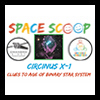CXC Home | Search | Help | Image Use Policy | Latest Images | Privacy | Accessibility | Glossary | Q&A
Supernova Blast Provides Clues to Age of Binary Star System
Quicktime MPEG With closed-captions (at YouTube)
If you've ever broken a bone, you'll know that X-rays are bad for humans. When doctors make an X-ray picture of a broken bone, they leave the room to avoid being hit by X-ray radiation every time. But the radiation you receive from an X-ray of your arm is 50 times less than the radiation we are blasted with every year from cosmic sources. Fortunately, our atmosphere blocks these X-rays so we're perfectly safe here on Earth.
Some of the most powerful sources of X-rays in the Universe are "X-ray binaries". These are made up of a normal star, like the Sun, and an ultra-compact type star called a "neutron star" or a black hole. As these two objects orbit one another, the neutron star's strong gravity pulls material off the companion star and onto it.
A new study of an X-ray binary called Circinus X-1 found that it is less than 4,600 years old! This makes it the youngest X-ray binary ever seen. Astronomers have detected hundreds of X-ray binaries throughout our Galaxy and others. But these older X-ray binaries only reveal information about what happens much later in the life of these systems. The new observations tell us new information about the stage just after the system forms.
[Runtime: 01:50]
Quicktime MPEG With closed-captions (at YouTube)
If you've ever broken a bone, you'll know that X-rays are bad for humans. When doctors make an X-ray picture of a broken bone, they leave the room to avoid being hit by X-ray radiation every time. But the radiation you receive from an X-ray of your arm is 50 times less than the radiation we are blasted with every year from cosmic sources. Fortunately, our atmosphere blocks these X-rays so we're perfectly safe here on Earth.
Some of the most powerful sources of X-rays in the Universe are "X-ray binaries". These are made up of a normal star, like the Sun, and an ultra-compact type star called a "neutron star" or a black hole. As these two objects orbit one another, the neutron star's strong gravity pulls material off the companion star and onto it.
A new study of an X-ray binary called Circinus X-1 found that it is less than 4,600 years old! This makes it the youngest X-ray binary ever seen. Astronomers have detected hundreds of X-ray binaries throughout our Galaxy and others. But these older X-ray binaries only reveal information about what happens much later in the life of these systems. The new observations tell us new information about the stage just after the system forms.
[Runtime: 01:50]
(Credit: NASA/CXC/April Jubett)
Return to Circinus X-1 (December 4, 2013)



